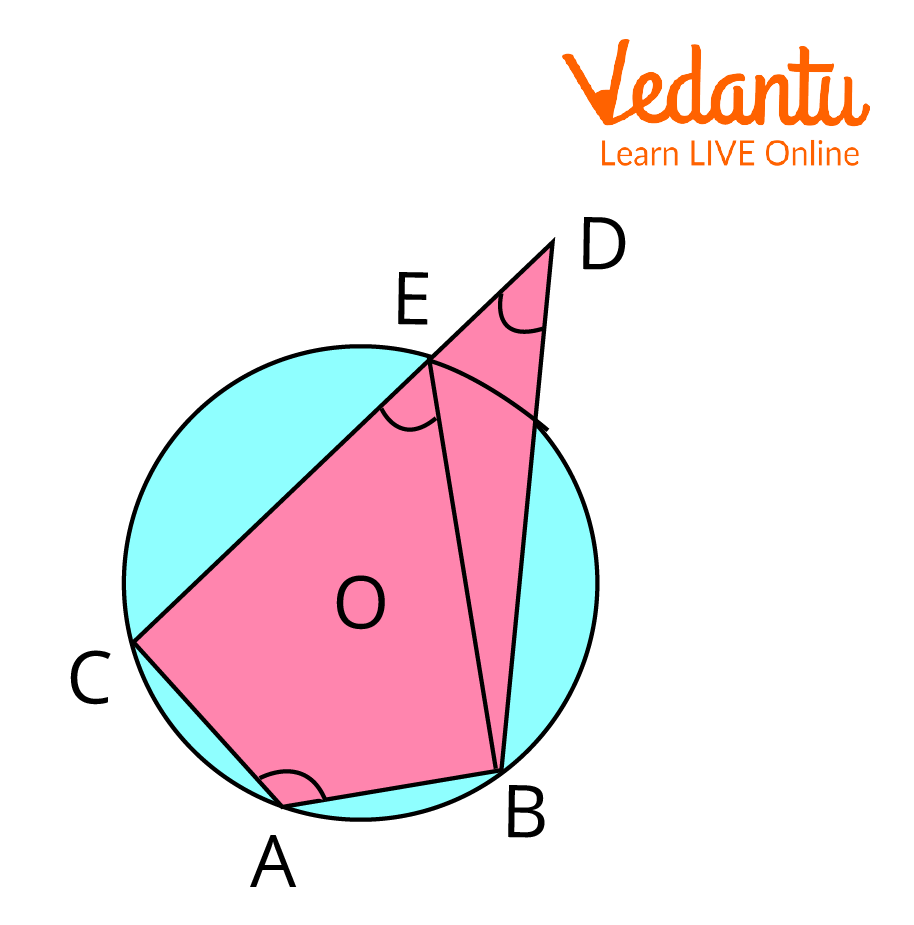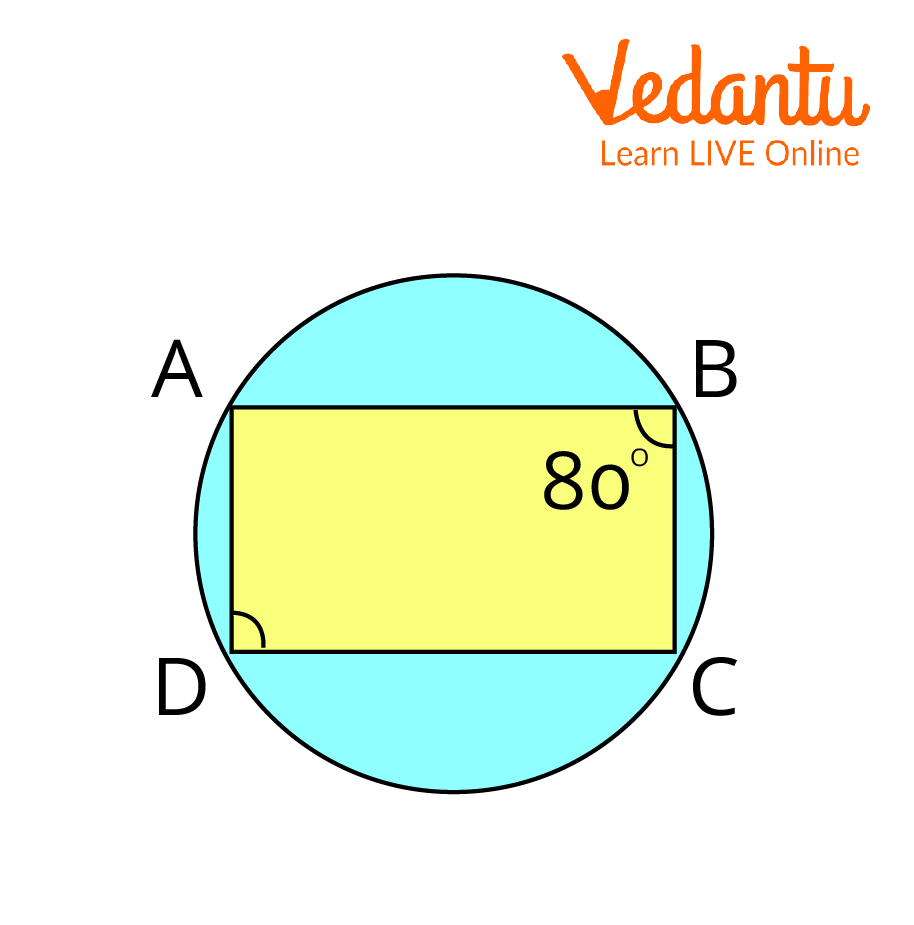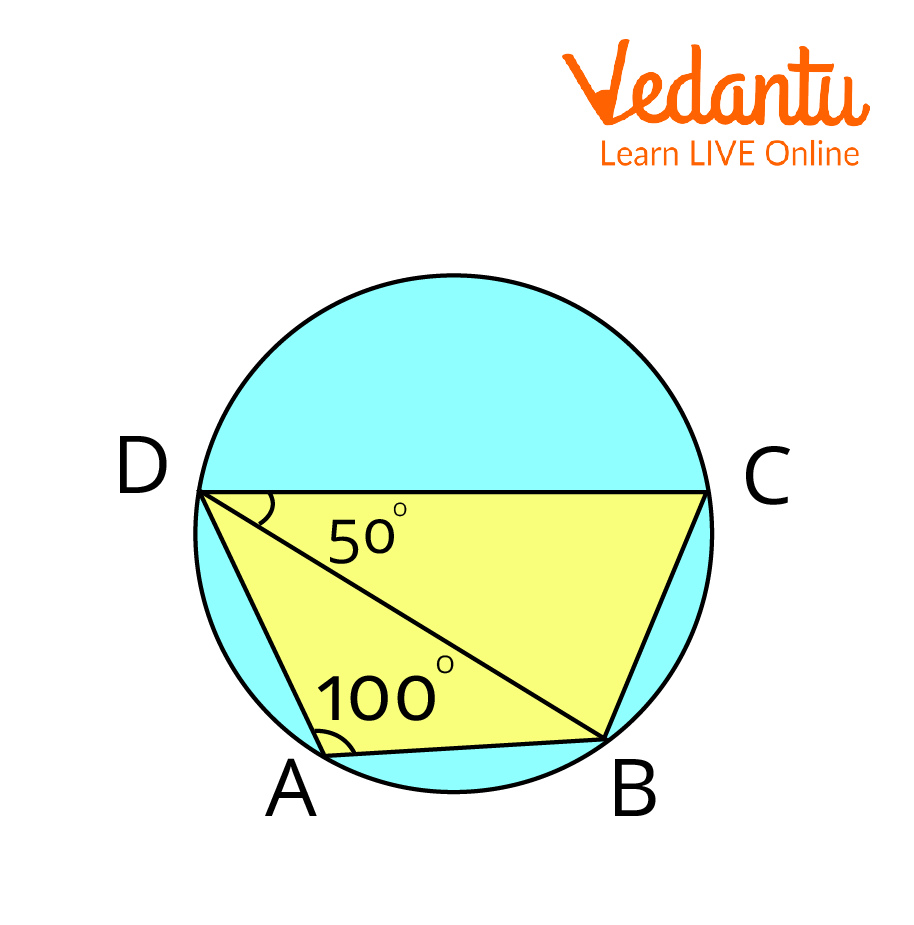




Proof, Formula, and Applications of Cyclic Quadrilateral Angle Theorem
In this article, we will prove the theorem and the converse of the theorem on the sum of opposite angles of a cyclic quadrilateral. The Cyclic Quadrilateral Theorem is a fundamental tool of Euclidean Geometry that connects the quadrilateral with the circles and tells us about the properties of cyclic quadrilaterals. In this article, some of the solved examples related to the application of the theorem and the converse of the theorem will also be discussed along with the applications of the theorem in the real world for a crystal clear understanding of the topic.
History of Euclid

Euclid
Name: Euclid
Born: 325 BC
Died: 265 BC
Field: Mathematics
Nationality: Egypt
Statement of the Theorem on the Sum of Opposite Angles of a Cyclic Quadrilateral
According to the Cyclic Quadrilateral Theorem, the sum of either pair of opposite angles in a cyclic quadrilateral is supplementary, i.e., 180 degrees.
Proof of Theorem on Sum of Opposite Angles of Cyclic Quadrilateral

Cyclic quadrilateral ABCD with centre O
Given: Consider a cyclic quadrilateral $A B C D$ in a circle with a centre at $O$.
To prove: $\angle B A D+ \angle B C D=180^{\circ}$
$\angle A B C+ \angle A D C=180^{\circ}$
$A B$ is the chord of the circle.
$\Rightarrow \angle 5=\angle 8$ .. (1) (Angles in the same segment are equal)
$B C$ is the chord of the circle.
$\Rightarrow \angle 1=\angle 6$...(2) (Angles in the same segment are equal)
$C D$ is the chord of the circle.
$\Rightarrow \angle 2=\angle 4 \ldots$... (3) (Angles in the same segment are equal)
$A D$ is the chord of the circle.
$\Rightarrow \angle 7=\angle 3 \quad \ldots$ (4) (Angles in the same segment are equal)
By angle sum property of a quadrilateral,
$\angle A+\angle B+\angle C+\angle D=360^{\circ}$
$\Rightarrow \angle 1+\angle 2+\angle 3+\angle 4+\angle 7+\angle 8+\angle 5+\angle 6=360^{\circ}$
$\Rightarrow(\angle 1+\angle 2+\angle 7+\angle 8)+(3+\angle 4+\angle 5+\angle 6)=360^{\circ}$
$\Rightarrow(\angle 1+\angle 2+7+\angle 8)+(-7+\angle 2+\angle 8+\angle 1)=360^{\circ}$
From equations (1), (2), (3), and (4),
$2(\angle 1+\angle 2+\angle 7+\angle 8)=360^{\circ}$
$\Rightarrow(\angle 1+\angle 2+\angle 7+\angle 8)=180$
$\Rightarrow(\angle 1+\angle 2)+(\angle 7+\angle 8)=180^{\circ}$
$\Rightarrow \angle B A D+\angle B C D=180^{\circ}$
Similarly, $\angle A B C+\angle A D C=180^{\circ}$
Hence proved.
The Converse of Cyclic Quadrilateral

Converse of Cyclic Quadrilateral Theorem
Given: ABCD is a quadrilateral with:
$\angle B A C+\angle B D C=180^{\circ}$
$\angle A B D+\angle D C A=180^{\circ}$
To Prove: $A B C D$ is a cyclic quadrilateral.
Proof: Since A, B, C are non-collinear, the circle passes through three collinear points.
Let us draw a circle $C_{1}$ with the centre at $O$.
Let us suppose $D$ does not lie on $C_{1}$. Now,
$\therefore A B C E$ is a cyclic quadrilateral.
But given
$\Rightarrow \angle B A C=\angle B E C=180^{\circ}$
Thus,
$\Rightarrow \angle B E C=\angle B D C$
Now, $\ln \Delta \mathrm{BDE}$,
$\Rightarrow \angle B E C=\angle B D E+\angle D B E$ (Exterior angle Property)
$\Rightarrow \angle B E C=\angle B D C+\angle D B E$
$\Rightarrow \angle B D C-\angle B D C=\angle D B E$
$\Rightarrow \angle D B E=0$
$\therefore$ $E$ and $D$ Coincides
Thus, our assumption was wrong.
$\Rightarrow$ Point $D$ lies on circle $C_{1}$
$\Rightarrow A B C D$ is a cyclic quadrilateral.
Hence proved.
Limitations of the Theorem on the Sum of Opposite Angles of a Cyclic Quadrilateral
The Cyclic Quadrilateral theorem only tells us about the opposite pair of angles and doesn't tell anything about the corresponding pairs of angles.
The cyclic quadrilateral is not applicable if any quadrilateral is formed with only three points on the circumference and a fourth point inside the circle.
Applications of the Theorem on the Sum of Opposite Angles of a Cyclic Quadrilateral
The cyclic Quadrilateral Theorem is used in computer programming.
It is used in graphic arts, logos, and packaging.
It is used in making paintings, sculptures, etc.
Solved Examples
1. Find the value of angle D of a cyclic quadrilateral, if angle B is $80^{\circ}$.

ABCD is a cyclic quadrilateral with angle B is 80 degrees.
Ans: Since $A B C D$ is a cyclic quadrilateral,
Hence, the sum of a pair of two opposite angles $=180^{\circ}$.
$\Rightarrow \angle B+\angle D=180$
$\Rightarrow 80^{\circ}+\angle D=180^{\circ}$
$\Rightarrow \angle D=180^{\circ}-80^{\circ}$
$\Rightarrow \angle D=100^{\circ}$
The value of angle $D$ is $100^{\circ}$.
2. Find the value of angle $D$ of a cyclic quadrilateral, if angle $B$ is $120^{\circ}$.
Ans:
As ABCD is a cyclic quadrilateral, hence the sum of a pair of two opposite angles $=180^{\circ}$.
$\Rightarrow \angle B+\angle D=180^{\circ} \\$
$\Rightarrow 120^{\circ}+\angle D=180^{\circ} \\$
$\Rightarrow \angle D=180^{\circ}-120^{\circ} \\$
$\Rightarrow \angle D=60^{\circ}$
The value of angle D is $60^{\circ}$.
3. In the figure given below, $A B C D$ is a cyclic quadrilateral in which
$\angle B A D=100^{\circ}$ and $\angle C D B=50^{\circ}$. find $\angle D B C$ ?

To find angle DBC in a cyclic quadrilateral
Ans:
Given,
$\angle B A D=100^{\circ}$ and $\angle C D B=50^{\circ}$
$\angle B A D+\angle B C D=180^{\circ}$ as these both angles are opposite angles of a cyclic quadrilateral.
$\Rightarrow \angle B C D=180^{\circ}-100^{\circ}=80^{\circ}$
In $\triangle B C D$,
$\angle B C D+\angle C D B+\angle D B C=180^{\circ}$
$\Rightarrow 80^{\circ}+50^{\circ}+\angle D B C=180^{\circ}$
$\Rightarrow \angle D B C=180^{\circ}-130^{\circ}$
$\Rightarrow \angle D B C=50^{\circ}$
Therefore,
$\Rightarrow \angle D B C=50^{\circ}$
Important Points to Remember
The sum of pairs of opposite angles of a cyclic quadrilateral is always supplementary.
If the sum of a pair of opposite angles of a Quadrilateral is supplementary, then the quadrilateral is a cyclic quadrilateral.
Important Formulas to Remember
If $ABCD$ is a cyclic quadrilateral in a circle with centre O, then $\angle B A D+ \angle B C D=180^{\circ}$.
If in a quadrilateral $ABCD$, $\angle B A D+ \angle B C D=180^{\circ}$, then $ABCD$ must be a cyclic quadrilateral.
Conclusion
In the article, we have discussed the proof of the Cyclic Quadrilateral Theorem and its converse. Applications of Cyclic Quadrilaterals are also discussed in this article. Cyclic Quadrilaterals are connecting links between polygons and circles. In all, we can say that the Cyclic Quadrilaterals are very important component of Geometry and connects the fundamental tools of geometry, i.e., Polygons and circles.
FAQs on Sum of Opposite Angles in a Cyclic Quadrilateral Theorem
1. What is the theorem for the sum of opposite angles in a cyclic quadrilateral?
The theorem, as per the CBSE syllabus, states that the sum of either pair of opposite angles of a cyclic quadrilateral is 180°. This means the opposite angles are supplementary. For instance, in a cyclic quadrilateral ABCD, the sum of angles ∠A and ∠C is 180°, and similarly, the sum of angles ∠B and ∠D is 180°.
2. What defines a quadrilateral as 'cyclic'?
A quadrilateral is defined as cyclic if all four of its vertices lie on the circumference of a single circle. If any vertex of the quadrilateral is inside or outside the circle, it cannot be called a cyclic quadrilateral. These vertices are also known as concyclic points.
3. What are the key properties of a cyclic quadrilateral?
Besides the main theorem on opposite angles, a cyclic quadrilateral has several other important properties:
All four vertices lie on the circumference of a circle (they are concyclic).
The sum of any pair of opposite angles is 180° (supplementary).
The exterior angle formed by extending one side is equal to the interior opposite angle.
The perpendicular bisectors of all four sides are concurrent, meeting at the centre of the circle.
4. How can you prove that the sum of opposite angles of a cyclic quadrilateral is 180°?
The proof relies on a fundamental circle theorem: 'The angle subtended by an arc at the centre of a circle is double the angle subtended by it at any point on the remaining part of the circle.' By considering a pair of opposite angles, say ∠B and ∠D of a cyclic quadrilateral ABCD, we see they are subtended by the arcs ADC and ABC respectively. The angles these arcs subtend at the centre sum to 360°. Therefore, the sum of the angles at the circumference (∠B + ∠D) must be half of 360°, which is 180°.
5. Is the converse of the cyclic quadrilateral theorem also true?
Yes, the converse of the theorem is also true and is an important concept in geometry. It states: If the sum of a pair of opposite angles of a quadrilateral is 180°, then the quadrilateral is cyclic. This means if you can prove that just one pair of opposite angles is supplementary, you can conclude that a circle can be drawn through all four of its vertices.
6. Does the theorem about opposite angles adding to 180° apply to all quadrilaterals?
No, this is a common misconception. This theorem is a special property that applies only to cyclic quadrilaterals. For general quadrilaterals like a non-cyclic parallelogram, rhombus, or trapezium, the sum of opposite angles is not necessarily 180°. This property is a unique identifier for quadrilaterals inscribed in a circle.
7. How does this theorem help in solving geometry problems?
This theorem is a powerful tool for solving problems involving circles and inscribed polygons. It allows you to establish a relationship between unknown angles. For example, if you are given one angle in a cyclic quadrilateral, you can immediately determine the measure of its opposite angle. This is crucial for finding missing angles, proving geometric relationships, and solving complex problems in higher-level mathematics and competitive exams.





































